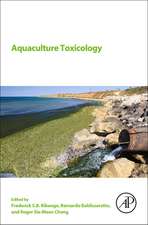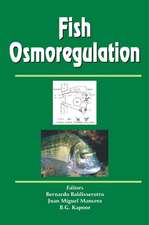Aquaculture Pathophysiology: Volume II. Crustacean and Molluscan Diseases
Editat de Frederick S.B. Kibenge, Bernardo Baldisserotto, Roger Sie-Maen Chongen Limba Engleză Paperback – 25 aug 2022
This comprehensive resource is ideal for researchers, teachers, students, diagnostic laboratory scientists, aquaculture technicians, and farmers who need to be competent across both finfish and shellfish health issues.
- Presents a focus on the disease process of major or emerging viral, bacterial, fungal and parasitic infections affecting aquacultured shellfish species e.g., shrimp, lobsters, crayfish, crabs, oysters, mussels, abalone and scallops
- Focuses on important or emerging environmental, nutritional, genetic, deformity, toxicological, endocrine disruption, and neoplastic diseases in crustaceans and mollusks
- Provides a review of the immunology of shellfish relevant to a practical understanding of disease diagnosis and management
- Includes an overview of laboratory diagnostic methods relevant to the detection of shellfish diseases
- Discusses the diverse risk factors of shellfish diseases and options for their control
| Toate formatele și edițiile | Preț | Express |
|---|---|---|
| Paperback (2) | 919.79 lei 5-7 săpt. | |
| ELSEVIER SCIENCE – 25 aug 2022 | 919.79 lei 5-7 săpt. | |
| ELSEVIER SCIENCE – 25 aug 2022 | 927.73 lei 5-7 săpt. |
Preț: 919.79 lei
Preț vechi: 1481.91 lei
-38% Nou
176.02€ • 191.13$ • 147.86£
Carte tipărită la comandă
Livrare economică 16-30 aprilie
Specificații
ISBN-10: 0323954340
Pagini: 692
Dimensiuni: 216 x 276 mm
Greutate: 1.58 kg
Editura: ELSEVIER SCIENCE
Public țintă
Researchers, teachers, students, diagnostic laboratory staff, clinical veterinarians, aquaculture disease practitioners, biologists, farmers, and all those in industry, government or academia who are interested in aquaculture, fisheries and comparative biology.Cuprins
1. Crustacean laboratory methods; 2. Crustacean Disease Terminology; 3. Crustacean immunology
SECTION II. VIRAL DISEASES
4. Covert Mortality Disease; 5. Crab viral diseases; 6. Crayfish viral diseases; 7. Infectious hypodermal and hematopoeitic necrosis virus disease; 8. Infectious myonecrosis virus disease; 9. Lobster Panulirus argus virus (PaV1) disease; 10. Monodon slow growth syndrome; 11. Spherical baculovirosis; 12. Shrimp Hemocyte Iridescent Virus (Decapod Iridescent Virus 1); 13. Taura syndrome virus disease; 14. Tetrahedral baculovirosis; 15. White spot syndrome virus disease of shrimp; 16. WSSV in wild mudcrabs; 17. White tail disease; 18. Yellow head virus disease
SECTION III. BACTERIAL DISEASES
19. Acute hepatopancreatic necrosis disease; 20. Crab larval luminescent vibriosis; 21. Chitinolytic Shell Disease; 22. Lobster Gaffkemia; 23. Mitten crab tremor disease; 24. Necrotising hepatopancreatitis (Hepatobacter penaei); 25. Shrimp mycobacteriosis; 26. Shrimp rickettsial disease; 27. Shrimp vibriosis
SECTION IV. PARASITIC DISEASES
28. Bitter crab disease (Hematodinium); 29. Crab ciliate disease (Mesanophrys); 30. Grey crab disease (Paramoeba perniciosa); 31. Lobster bumper car disease (Anophryoides haemophila); 32. Mud crab Octolasmis spp. barnacles; 33. Shrimp fouling organisms; 34. Shrimp gregarines (White Feces Syndrome); 35. Shrimp haplosporidiosis
SECTION V. FUNGAL DISEASES
36. Cotton shrimp; 37. Crab Lagenidium disease; 38. Crayfish plague; 39. Crayfish Thelohania disease; 40. Enterozytozoon hepatopenaei microsporidiosis; 41. Lobster Haliphthoros disease; 42. Shrimp Fusarium disease; 43. Shrimp larval mycosis
SECTION VI. NUTRITIONAL DISEASES
44. Vitamin deficiencies in shrimp; 45. Soft shell and blue shell syndrome in shrimp; 46. Crab larval mortality and nutrition
SECTION VII. ENVIRONMENTAL DISEASES
47. Black gill disease in shrimp; 48. Endocrine disruption in crustacea; 49. Pollutant toxicoses – pesticides, heavy metals, industrial organic chemicals in crustaceans; 50. Shell diseases; 51. Lobster Epizootic Shell Disease
SECTION VIII. GENETIC AND NEOPLASTIC DISEASES
52. Abdominal segment deformity in shrimp; 53. Inbreeding of shrimp, crabs and lobsters; 54. Neoplasia in decapod crustacea
SECTION IX. MOLLUSK DISEASES
55. Molluscan Disease Laboratory Methods; 56. Molluscan Disease Terminology; 57. Mollusk immunology; 58. Pearl Oyster Diseases; 59. General Pathology and Diseases of Abalone
SECTION X. VIRAL DISEASES
60. Abalone herpesvirus; 61. Diseases of viral origin in clams, mussels and scallops; 62. Hemocytic infection virus disease (oysters); 63. Ostreid Herpesvirus Disease; 64. Oyster velar virus disease; 65. Viral gametocytic hypertrophy (oysters)
SECTION XI. BACTERIAL DISEASES
66. Vibriosis of Larval Scallops; 67. Nocardiosis in Oysters; 68. Scallop Chlamydia and Rickettsia-like organisms; 69. Vibriosis in green mussels
SECTION XII. PARASITIC DISEASES
70. Bonamiasis; 71. Molluscan haplosporidiosis; 72. Kidney coccidiosis (scallop, abalone, mussels, oysters, clams); 73. Marteiliosis; 74. Mikrocytosis mackini; 75. Nematopsis protozoan infections; 76. Perkinsosis; 77. Shell boring polychaetes (Mudworms) and sponges affecting oysters, scallops and abalone.
SECTION XIII. FUNGAL AND NUTRITIONAL DISEASES
78. Ostracoblade implexa disease (oysters); 79. Sirolpidium zoophthorum larval mycosis; 80. Microsporidiosis (Steinhausia mytilovum); 81. Hatchery Nutritional Conditions of Mollusks
SECTION XIV. ENVIRONMENTAL DISEASES
82. Pollutant toxicoses of mollusks; 83. Endocrine disruption in mollusks; 84. Ocean acidification
SECTION XV. GENETIC AND NEOPLASTIC DISEASES
85. Inbreeding, genetic selection and manipulation of oysters; 86. Hemocytic neoplasia in mollusks
Descriere
Aquaculture Pathophysiology, Volume I. Finfish Diseases is a diverse, practical reference on finfish diseases impacting aquaculture. It is intended for the veterinarian, fish health biologist or extensionist, fish pathologist, and fish health diagnostician supporting the management of major and emerging infectious and non-infectious health risks for the key temperate, subtropical and tropical finfish species of commercial and fisheries importance. This volume should be read in partnership with Volume II on shellfish diseases as the principles and approach to the diagnosis and management of aquacultured animal species are similar, and typically researchers, teachers, students, diagnostic laboratory scientists, aquaculture technicians, and farmers need to be competent across both finfish and shellfish health issues.
• A focus on the disease process of major or emerging viral, bacterial, fungal, and parasitic infections affecting aquacultured finfish species e.g. salmonids, carp, tilapia, eel, barramundi • A focus on important or emerging environmental, nutritional, genetic, deformity, toxicological, and endocrine disruption and neoplastic diseases in finfish • A review of the immunology of finfish relevant to a practical understanding of disease diagnosis and management • An overview of laboratory diagnostic methods relevant to detection of finfish diseases • Concise discussion on the diverse risk factors of finfish diseases and options for their control





















